Multiple Warheads: Alphabet to Infinity #1 ($3.99, Image)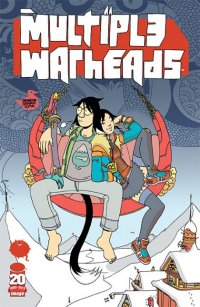
by D.S. Randlett (@dsrandlett)
It’s been a good year for Brandon Graham. I had never heard of him before this year, largely because I’ve been tuned out of comics for much of his career. The industry (and the folks here at Thor’s) managed to pull me back in last year, at around the time of DC’s New 52. Graham blasted on to my scene with the Prophet reboot, a book that I am perpetually in anticipation of. Unfortunately, my working stiffitude affords me a choice between keeping up with the new or catching up with what I may have missed, so works like the acclaimed King City and past volumes of Multiple Warheads have had to stay at the fringes of my radar, coveted but unread.
Luckily, the first issue of the latest Multiple Warheads entry is very new-reader friendly. Not in the way that comic books stereotypically are when they announce themselves to be such, with their clunky slabs of exposition as to what happened “last time.” Rather, Graham makes it feel as if there were no “last time,” electing to plunge new readers into a world that is post-apocalyptic sci-fi, road trip comedy, and high fantasy all in one. The story begins in media res, with lovers Sexica and Nikoli driving through a very… different Russia, and Graham uses a deft command of storytelling to make people new to this world feel at home.
Or as “home” as is possible, at any rate. Much in this book will feel familiar to readers of Prophet: decadent cities built on the backs of giant, headless quadrupeds, hive-mind critters with tentacles faces that sniff out food for radiation at convenience store cash registers, cigarettes that sing plaintive tunes, Graham’s ability to pull things out of an insane dreamscape and make it feel absolutely natural is on full display here. But rather than exploring the savagery of a broken world (as in Prophet), here he explores the whimsy that such a world might afford and the freedom of second chances.
This story is only beginning, and not much actually happens in terms of plot. This is very much an introduction, and the possibility of conflict for our main characters doesn’t appear until the very last page. I can tell you what happens in a sentence: A pair of lovers drives, makes love, and reminisces while a hitwoman pursues a contract. It ends up being all we need. Graham uses this first issue to establish a sense of rhythm. His page layouts are unlike anything I’ve seen in quite some time, and the pace of the story unfolds in a way that’s only possible in the comic book format. Pages don’t feel broken up into panels as much as they feel like flowing whisps of story, each page moving into the next while being a work of art in its own right.
Sometimes a comic book can celebrate the entire medium simply by being different, and by being very, very good. This is one of those times.
Rating: 




Out of a Possible 5 Stars
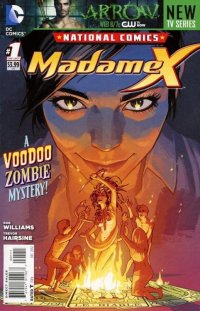 NATIONAL COMICS: MADAME X #1 One-Shot (DC Comics, $3.99)
NATIONAL COMICS: MADAME X #1 One-Shot (DC Comics, $3.99)
By Devon Sanders (@devonsanders)
“Ceci n’est pas Madame Xanadu.”
Nope. It’s not. Never mind the fact that she’s an oracle. Looks like Madame Xanadu. Has a flair for the dramatic. Reads The Tarot.
Nope. It’s someone else. Only this one’s set in Louisiana and because of the Madame Xanadu already established with the pages of DC Comics New 52-based series, Justice League Dark. Nope; the far more interesting woman holding The Tarot and predicting futures in the latest and only issue of National Comics: Madame X #1 ain’t Madame Xanadu.
It’s Madame X.
“Ceci n’est pas Madame Xanadu.”
National Comics, as a title, is a conundrum. The New DC 52 Universe is barely a year old and National Comics is a book designed to introduce new readers to different interpretations of existing characters such as Kid Eternity and Rose & Thorn. Here’s the thing though; the characters introduced in its pages aren’t New 52 DC Universe characters. And, here’s the another thing; the characters introduced in National are usually far more interesting than their New 52 counterparts…
Leading us back to Madame X….
This book is pretty damned entertaining. And sadly, won’t be good for much outside of one good read. Madame X is done by the top-notch writer/artist combo of Rob Williams and Trevor Hairsine, the men who brought you the thankfully-soon-to-be-back-in-print series, Cla$$war. When a prominent Louisiana businessman winds up dead, former celebrity psychic Madame X turned crime consultant is brought in. The cards are laid out and a mystery involving voodoo, zombies, politics and its use of theatrics, unfolds into something I wish we could revisit soon but alas…
Because of continuity, “Ceci n’est pas Madame Xanadu.” Damned shame.
Writer Rob Williams has spun one hell of a taut tale; one I’m sure would have legs if ever allowed beyond National Comics‘ and continuity’s limitations. His pacing is tight and dialogue flows easily from his characters’ lips while artist Trevor Hairsine’s beautiful figure work reminds the reader why Marvel once tagged him as one of their most promising “Young Guns”.
This comic, while great, comes across as something of a whim.
This issue left me wanting more; I want more of this Madame X/Xanadu. She has gravity. She could be given story. Sadly, National Comics: Madame X will remain what it is; a good read reminding this reader of the limitations inherent in current comics continuity.
Welcome to the New 52… or not.
This isn’t New 52, after all.
Rating: 




Out of a Possible 5 Stars
Bravest Warriors #1 (Kaboom!, $3.99) 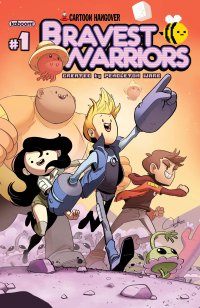
By Adam Prosser
Recapturing “the magic of childhood” is one of the holy grails of fiction. We all remember our childhoods, and yet there’s a certain veil drawn across it created by the fact that our brains just plain worked differently back then. Childhood is a subject, like the biography of an artist, where a literal recounting of the facts rarely gets to the true spirit of the thing. Which is why genre fiction is a great medium for this kind of thing—it lets the storyteller approach it indirectly and thus conjure up an impression that cuts deeper than factual truth.
Pendleton Ward gets this, although I doubt he’d phrase it in such a highfalutin’ fashion. The creator of Adventure Time and now Bravest Warriors, Ward’s work comes close to feeling like it’s erupted right from a kid’s id at times. Of course, at other times, the hand of an adult is evident, shaping the cartoons into something more sophisticated—we’ve already got an Axe Cop, after all, and we don’t really need another one—but both these cartoons ring true to the central premise of “playtime brought to life”. Indeed, one of the most compelling aspects of Adventure Time is how it nails childhood’s oddly easygoing relationship with the dark and ominous; it’s set in a seemingly post-apocalyptic landscape devoid of humans (except for the lead character), and there are frequent appearances by the bizarre, the grotesque, and the downright horrific, and yet the candy-bright tone and good-natured feel remain along with its protagonist’s essential good nature.
While I’m a huge fan of Adventure Time, I’ve been mostly ignorant of Bravest Warriors until reading this comic. Based on that evidence, Bravest Warriors is essentially more of the same, except it riffs on pop SF and comic book space opera as opposed to fantasy. It also lacks AT’s underlying subversiveness and unsettling weirdness, leading me to conclude this is intended more for younger readers and viewers. There’s nothing wrong with that, of course, but it does make this feel like this is a fluffier confection, even though it’s not devoid of depth itself.
There’s not much to the plot of Bravest Warriors #1, which seems to be part of the point. A quartet of young heroes blow up planets and have over-the-top laser gun battles in the name of, supposedly, saving various cute little aliens; their adventures seem to be driven less by urgency and more by the capricious whims of a group of kids enacting a make-believe adventure, making up a story as they go along. Which is probably why a large stretch of the comic is devoted to them simply watching movies—actually, movie trailers—in their headquarters, a giant invisible robot.
Like I say, while there’s a fair amount of the random imaginativeness of Adventure Time here (particularly manifested in the form of Plum, an alien babe with two brains, one of whom is evil) there’s very little outright weirdness of the kind that makes AT special. The focus is more on the subtext of these kids who are standing right on the cusp of puberty and dealing with emotions they don’t understand—they’re given the entire galaxy as a playground, but they still don’t quite know what they want. That’s interesting but a lot more subtle than AT, and it makes for a slightly less compelling narrative…to an adult.
To a kid, of course, this should be pure catnip, and that is, after all, the audience Kaboom! is courting. The Adventure Time comic has almost instantly become an enormous success, spawning a couple of spinoffs with remarkable speed and reminding us all of a time when licensed kid’s properties were the bread and butter of the comic book industry. Anything that can make inroads towards getting kids back to reading comics is to be welcomed with open arms, and Bravest Warriors should help continue that work nicely.
Rating: 




Out of a Possible 5 Stars
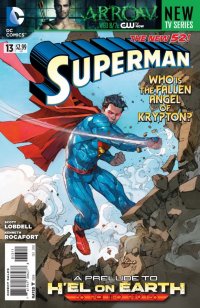 Superman #13 ($2.99, DC)
Superman #13 ($2.99, DC)
by D.S. Randlett (@dsrandlett)
You’ve probably heard the news: Clark Kent has quit the Daily Planet. What’s funny is that I’ve heard more about this from the “real” journalists that I follow on Twitter than I have the comics press, and I’m guessing that this is because the comics press knows the rules. This is a development that I actually welcome, and hopefully it actually goes somewhere. I can see Clark Kent as a Glenn Greenwald or Matt Taibbi style blogger. It fits the character, and having him quit his job on principle is an appealing and dramatic development in a comic that has heretofore been spinning its wheels and absent of a point of view thanks to issues settling on a creative team.
The good news is that this title seems to have gotten it together. I was a bit nervous about the hiring of Scott Lobdell as the writer on this series, and not because he’s terrible. When he’s good he displays a good grasp of character and plot, and can come up with some fun and inventive action sequences, but he’s never been great. He’s very much a hired gun type, and he gets a lot of work, and as a result he often falls back on some very worn out tropes. Which Lobdell would we be getting? The Superman annual didn’t exactly assuage my fear, as it read like Superman going through a tour of the newly integrated elements from Wildstorm, and let’s just say that that particular issue didn’t really display a grasp of the title character. The Zero issue was a good looking piece of fluff. Thankfully, Lobdell manages to acquit himself rather well this month. This issue’s Superman is a bit more confident and true to form: he’s starting to feel like an actual character again, and the title is developing an actual point of view. There’s barely a story here, though. What there is of it is mainly concerned with tying up some of the loose ends from the title’s first year of clusterfuckery and setting up a Super family crossover, but it’s not without its charms and moments.
Kenneth Rocafort really brings it here. He imbues Superman with a sexuality that’s long been missing from the character and evokes a sense of sinewy but intelligent brawn. Of all the recent visual takes on the character, this is by far the best, and a far cry from the almost childlike image by the artist seen on the cover of the annual. In general, Rocafort adopts a style reminiscent of European scifi comics, and it really works. There’s a lot of detail in the the book’s more fantastic elements, and it really breathes new visual life into this title’s world. The coloring, which also has that watercolory European feel, is fantastic and evokes the romanticism that lies at the heart of Superman.
The book isn’t perfect (thought bubbles are an odd choice), and time will tell if this team really “gets it,” but there are a few of reasons for fans of Superman to be at least cautiously optimistic.
Rating: 




Out of a Possible 5 Stars
ENDINGS/BEGINNINGS
Journey Into Mystery #645 (Marvel, $2.99)
FF #23 (Marvel, $2.99)
Captain America #19 (Marvel, $3.99)
Invincible Iron Man #527 (Marvel, $3.99)
Punisher: War Zone #1 of 5 (Marvel, $2.99)
Wolverine MAX #1 (Marvel MAX, $3.99)
By Jeb D.
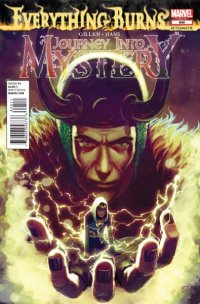
Regardless of what Marvel Now! turns out to be (positive: Uncanny Avengers #1 is a terrific start; negative: issue #2 is already delayed), its restructuring of the Marvel publishing schedule signals the end of several critically-lauded series that wrap up this week. We also get a pair of non-Marvel Now! #1’s, as another fine series begins its death-throes, while the MAX imprint gets a new recruit.
The Big 2 continue their efforts to prop up their publishing divisions by leveraging their presence in mainstream news outlets, and media like films and TV, in an attempt to put new sets of eyes onto their comics, with little to show for it (I believe the figure was that more than 95% of purchases of “New 52” books are made by regular comics readers). Every now and again, though, they do manage outreach to the audience beyond the usual spandex junkies, and it’s rarely due to canny marketing or widespread mainstream exposure: sometimes a good writer, telling a good story, clicks with comics readers in a way that encourages them to share it with their non-comic-reading friends. Though it’s unlikely to endure in quite the same way that Neil Gaiman’s classic has, Kieron Gillen’s Journey Into Mystery, with its mixture of myth, humor, skewed sense of relationships and romance, and, well… mystery… has tapped into some of that fantasy-oriented Sandman/Fables audience (or their kids): it’s not Marvel’s biggest seller, but if its online community is any indication, it’s far and away their most beloved. And, of course, it’s ending. And while one could take Marvel to task for killing this particular golden (well, as least silver) goose, it has to be said that they pretty much gave Gillen a free hand to spin his dense, layered yarn of young Loki and his mythic (mis)adventures, and for that they should be commended.
This issue stands out from some of the other Marvel farewells this week in (mostly) putting the finishing touches on a story: specifically, the “Everything Burns” crossover with the regular Thor title (which itself grew out of the “Fear Itself” event, which…). Though Matt Fraction will wrap up the “Everything Burns” storyline in the upcoming Thor #22, there’s no question that Gillen is emphatically closing the books on the current version of “Kid Loki”: in this issue, he confronts his “older” (and yet previous) self, faces tough choices (among them, whether to sacrifice himself for the good of billions of human souls… or whether such clichéd choices are even binding or relevant in a modern world with a very different set of myths), sees a bittersweet version of a life he might have had, and finds himself transformed as he heads into the Young Avengers series, in ways that will likely provoke plenty of division and discussion.
And while Alan Davis’ work on Thor during “Everything Burns” has set a pretty high bar for Asgardian artwork these days, this issue of JIM features stunning interiors from regular cover artist Stephanie Hans, and I frankly do her a disservice by not devoting an entire, detailed paragraph to her imaginative, emotionally charged painting; suffice to say, this is one gorgeous comic.
I can’t speak for Gillen, of course—there’s certainly a sense of melancholy in the final JIM letters page, which features, among other things, a note from Loki actor Tom Hiddleston—but I’d say that this version of JIM got to where it needed to, and called it quits at the right time. There’s only so long you can maintain the emotional heights that kept the series at the top of so many Wednesday stacks, and between the Asgardian regulars, occasional humans, the Manchester gods, and the various demons, devils and monsters with whom Loki interacted, Gillen’s gimlet eye pretty much took in all you could have asked for in a comics creator exploring the relationships between classic myths and the more cynical world we inhabit today. Though I’m sad to see this series end, I’m looking forward to seeing what young Loki can bring to the more contemporary setting of Young Avengers; that Gillen will be succeeded on JIM by one of my favorite writers, Kathryn Immonen, suggests that it’s not time to drop this one from the pull list just yet.
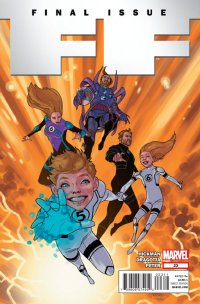 In any other week (i.e., one that didn’t feature Journey Into Mystery #645), I’d be falling all over myself to heap praise on FF #23, which concludes Jonathan Hickman’s time with Marvel’s first family—a wonderfully extended family in Hickman’s hands. It’s time for future Franklin Richards to return to his own time, but before he goes, he takes his younger self on a journey through the potential of his powers, and his imagination, that brings out the playful best in artist Nick Dragotta and colorist Cris Peter, as Franklin and Leech carouse through a world of fantastical visions (ranging from dinosaurs riding with the cavalry to vampire schoolteachers on Easy Rider-style choppers). The adult Franklin also looks in on Val’s challenges teaching math to the other First Foundation students, regales Johnny and Ben over drinks with a hilarious story about an encounter they’ve yet to experience, and finally bids farewell to the parents who want nothing more from him than the answer all parents crave: “Son, did we do a good job?” It’s been quite some time since anyone has so effectively nailed the family relationships at the core of the FF, and not even Franklin’s answer to that question is as hauntingly memorable as the look on Reed’s face as he poses it. If we hadn’t already had a fascinating glimpse at what Matt Fraction and the Allreds have lined up for this book, I’d be pretty damned depressed.
In any other week (i.e., one that didn’t feature Journey Into Mystery #645), I’d be falling all over myself to heap praise on FF #23, which concludes Jonathan Hickman’s time with Marvel’s first family—a wonderfully extended family in Hickman’s hands. It’s time for future Franklin Richards to return to his own time, but before he goes, he takes his younger self on a journey through the potential of his powers, and his imagination, that brings out the playful best in artist Nick Dragotta and colorist Cris Peter, as Franklin and Leech carouse through a world of fantastical visions (ranging from dinosaurs riding with the cavalry to vampire schoolteachers on Easy Rider-style choppers). The adult Franklin also looks in on Val’s challenges teaching math to the other First Foundation students, regales Johnny and Ben over drinks with a hilarious story about an encounter they’ve yet to experience, and finally bids farewell to the parents who want nothing more from him than the answer all parents crave: “Son, did we do a good job?” It’s been quite some time since anyone has so effectively nailed the family relationships at the core of the FF, and not even Franklin’s answer to that question is as hauntingly memorable as the look on Reed’s face as he poses it. If we hadn’t already had a fascinating glimpse at what Matt Fraction and the Allreds have lined up for this book, I’d be pretty damned depressed.
When Brian Bendis recruited his old Caliber Comics buddy Ed Brubaker to Marvel, his work on books like Sleeper and 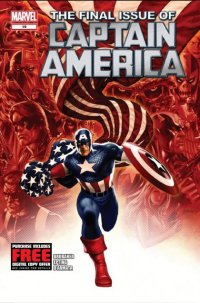 Gotham Central made him seem the natural heir to Bendis’ Daredevil (which, of course, he eventually was). What seemed less of a slam-dunk was Brubaker’s “dream” Marvel job: Captain America. That the book would be well-written was a given; that it would explore, deepen, and renew Cap’s mythology, while telling highly entertaining tales of action and espionage, was not; nor would most have expected his resurrection of Bucky Barnes to be, not a gimmick, but a compelling storyline that introduced an effective new (well, mostly new) character into the Cap mythos. Early on, Marvel editorial seemed to understand that they had something important on their hands, as they allowed Brubaker to maintain his own continuity on Cap (and Daredevil) without interference from ongoing events and crossovers… save, of course, the “Death of Cap”, a storyline Brubaker had planned before it occurred to anyone that it might work nicely in the climax of Civil War. And now, after 100 or so issues, Brubaker reunites with Steve Epting to put a cap, as it were, on the Captain America series that will stand as the post-Kirby reference for the character.
Gotham Central made him seem the natural heir to Bendis’ Daredevil (which, of course, he eventually was). What seemed less of a slam-dunk was Brubaker’s “dream” Marvel job: Captain America. That the book would be well-written was a given; that it would explore, deepen, and renew Cap’s mythology, while telling highly entertaining tales of action and espionage, was not; nor would most have expected his resurrection of Bucky Barnes to be, not a gimmick, but a compelling storyline that introduced an effective new (well, mostly new) character into the Cap mythos. Early on, Marvel editorial seemed to understand that they had something important on their hands, as they allowed Brubaker to maintain his own continuity on Cap (and Daredevil) without interference from ongoing events and crossovers… save, of course, the “Death of Cap”, a storyline Brubaker had planned before it occurred to anyone that it might work nicely in the climax of Civil War. And now, after 100 or so issues, Brubaker reunites with Steve Epting to put a cap, as it were, on the Captain America series that will stand as the post-Kirby reference for the character.
Unlike JIM, Brubaker’s swan song on Cap isn’t intended to set up the character’s new status quo, so much as reaffirm it: Cap’s visiting the hospitalized William Burnside (Steve Englehart’s “Cap of the 50’s”), badly injured in action, to reassure him that he, and all the other various successors to the winged helmet, can forever set down the burden of Star-Spangled Avenger, in favor of the original. Steve’s reflections include a potted recount of Rogers’ career, his transformation into Captain America, his relation with Bucky, half-forgotten incidents like his time as Nova (does Marvel really acknowledge Steve Rogers having been in action during Watergate?), and the responsibilities that go with it. It’s an eloquent capper, nicely illustrated by Epting, but unlike JIM or FF, it’s not particularly a series high point as a single issue; as the epilog to the final collected edition of Brubaker’s run, though, it will bring a catch to a few throats.
There’s no question that there are big changes ahead for this series, with Rick Remender and John Romita Jr. taking over. Let’s think positive, though: with Brubaker’s recent reintroduction of the Bicentennial-era “Madbombs” into Cap continuity, the new creative team would seem an ideal match for bringing on some late-Kirby-era craziness; better to strike out in a completely over-the-top direction, certainly, than anyone trying to match what Brubaker/Epting/Lark/Guice and company have achieved… because that simply isn’t going to happen.
 Matt (him again!) Fraction’s challenge with Invincible Iron Man has, perhaps, been the greatest of any of the series wrapping up this week, as we’re now three movies into Robert Downey Jr.’s redefinition of the character, with the fourth on the way; and given that the series was still dealing with the effects of Warren Ellis’ “Extremis” run when he took over, he’s managed to keep a good balance between the demands of the film series (bringing the Stane family back to prominence), while tossing out the bits he had no need for (Paul Bettany’s Jarvis would appear to be finished in the comics). I’m not the biggest Salvatore Larroca fan, but he does a perfectly serviceable job in an issue devoted more to Tony and his supporting cast reflecting on the messes he gets himself into, than much in the way of action. The book ends with Tony, in armor, heading for the sky; whether the next creative team will find it as easy as Fraction did to balance the demands of comics and movies, will determine just how high he flies.
Matt (him again!) Fraction’s challenge with Invincible Iron Man has, perhaps, been the greatest of any of the series wrapping up this week, as we’re now three movies into Robert Downey Jr.’s redefinition of the character, with the fourth on the way; and given that the series was still dealing with the effects of Warren Ellis’ “Extremis” run when he took over, he’s managed to keep a good balance between the demands of the film series (bringing the Stane family back to prominence), while tossing out the bits he had no need for (Paul Bettany’s Jarvis would appear to be finished in the comics). I’m not the biggest Salvatore Larroca fan, but he does a perfectly serviceable job in an issue devoted more to Tony and his supporting cast reflecting on the messes he gets himself into, than much in the way of action. The book ends with Tony, in armor, heading for the sky; whether the next creative team will find it as easy as Fraction did to balance the demands of comics and movies, will determine just how high he flies.
Punisher: War Zone #1 is both a beginning and an ending: the first issue of a 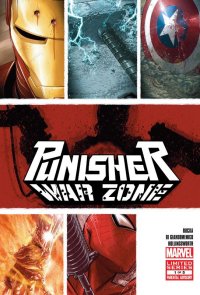 miniseries that brings to a close Greg Rucka’s all-too-brief run on the character. Given the heights to which Ennis and Aaron brought Frank Castle under the MAX imprint, it seemed unlikely that a street-level crime-comic version of The Punisher could possibly measure up in the more restricted environment of the regular Marvel U (particularly while Rick Remender was gleefully engaged in literal deconstruction of the character elsewhere). If anyone could do it, though, Rucka was the guy, and his storyline that culminated in Frank taking on an unexpected protégé, while finally turning the police against him for good, was up there with Bendis’ Daredevil as a way of taking what was inherent in the character and following it to its logical conclusion. But as Rucka has been widely quoted, Marvel made it clear to him that Frank had obligations on the spandex side of things, and with his upcoming addition to one of Marvel’s superteams (I assume it’s Thunderbolts or Dark Avengers or whatever), this hardened vigilante had to step aside for costumed hijinx, and Rucka decided that was where he would get off. Given how often we’ve seen talent unceremoniously booted off a title when there are editorial disagreements, I’m a little surprised that Marvel had Rucka go ahead and write this mini; I’m even more surprised to find that he appears to be using this series to demonstrate to Marvel just how wrong they are: Frank doesn’t belong in a spandex world.
miniseries that brings to a close Greg Rucka’s all-too-brief run on the character. Given the heights to which Ennis and Aaron brought Frank Castle under the MAX imprint, it seemed unlikely that a street-level crime-comic version of The Punisher could possibly measure up in the more restricted environment of the regular Marvel U (particularly while Rick Remender was gleefully engaged in literal deconstruction of the character elsewhere). If anyone could do it, though, Rucka was the guy, and his storyline that culminated in Frank taking on an unexpected protégé, while finally turning the police against him for good, was up there with Bendis’ Daredevil as a way of taking what was inherent in the character and following it to its logical conclusion. But as Rucka has been widely quoted, Marvel made it clear to him that Frank had obligations on the spandex side of things, and with his upcoming addition to one of Marvel’s superteams (I assume it’s Thunderbolts or Dark Avengers or whatever), this hardened vigilante had to step aside for costumed hijinx, and Rucka decided that was where he would get off. Given how often we’ve seen talent unceremoniously booted off a title when there are editorial disagreements, I’m a little surprised that Marvel had Rucka go ahead and write this mini; I’m even more surprised to find that he appears to be using this series to demonstrate to Marvel just how wrong they are: Frank doesn’t belong in a spandex world.
It’s appropriate that the miniseries kicks off with an encounter with Spider-Man, given the Punisher’s origins in Amazing Spider-Man. And it’s always nice to see a well-written version of Spidey as the antagonist in the story; kudos to Rucka for nailing the character in such a relatively brief appearance, and for making him an imposing opponent for the Punisher, rather than the wisecracking punching bag he too often winds up as. It’s after the fight has ended inconclusively, though, that Rucka gets to the meat of things: Spidey visits Avengers tower, where he tells the team that Frank has finally gone too far, and that it’s time to put an end to the character: a murderous vigilante has no place in a world of super-powers… or in a comic universe of super-powered fantasy, says Rucka. There’s agreement from some members, disagreement from others, and as plans are put in motion to bring Frank Castle in for the last time, one member of the team has other ideas. The dialogue in this section is perfectly judged: not only are the character voices well realized, but stripped of the story’s context, this could almost be Rucka and Tom Brevoort going at it about the fate of Rucka’s Punisher series in the first place.
I’m sorry that Rucka’s previous Punisher artist, Marco Checchetto, isn’t doing this series, as he was so completely in simpatico with Rucka’s tough-minded street scenes and bloody mayhem. Carmine di Giandomenico’s work is serviceable, but less consistent, and he shares Checchetto’s one flaw: his rakishly piratical depiction of Frank himself.
While it’s certainly a shame that Marvel no longer felt they could let Rucka continue running his own personal Punisher-verse, as I reflect back on that series, and indeed on books like Journey Into Mystery and FF, it’s worth remembering that there are still corners of the Marvel-verse that can deliver pleasures quite apart from the convolutions of the multiplicity of Avengers and X-Men titles, and if what we saw in the recent Point One preview issue is any indication, there’ll still be a few such gems to add to the pull list under the Marvel Now! banner.
 I’m not entirely sure why Marvel decided that Wolverine needed a Wolverine MAX series: yes, they love adding new Wolverine series, but the MAX imprint isn’t really a “universe” that wants to expand its cast of characters (just for starters, it doesn’t even have The Punisher anymore), and while Marvel gets some nice prestige points when, say, Garth Ennis does a MAX book, the “mature readers” tag ensures that this will never reach the sales potential of a regular Wolverine title, thus presumably making it a fairly expensive book in terms of paying the creative team. And, yeah, while there’s a bit of bad language and nudity, and plenty of violence, it’s not really envelope-pushing, and nothing that happens in this book couldn’t happen (hasn’t happened) in a regular Wolverine title, with just a bit of %#^@! in place of the “fuck!“s, and some carefully discreet artwork to hint at the blood and boobies. Writer Jason Starr does his best to make this more interesting than your usual “origin” issue: having Wolverine, following an incident of violence, try to dredge up his past from fractured memories and flashbacks is an old trope for the character, but it does allow new readers to sort of keep up with Logan as he learns about himself. The question is, though, whether there’s any reason to suppose that new readers are going to be buying this: it seems far more likely that this will be of interest to Wolverine fans that are just curious to see what his adventures might be like with the brakes off. Artists Roland Boschi (handling the contemporary adventure) and Connor Willumsen (on the flashbacks and memories) present a fairly extreme contrast in styles, making it easy to follow the various segments, even if the transitions are a bit jarring; typically fine cover from Jock. I honestly don’t know who the target audience for this book would be, short of Wolverine completists. But, then, their money’s as good as anyone else’s.
I’m not entirely sure why Marvel decided that Wolverine needed a Wolverine MAX series: yes, they love adding new Wolverine series, but the MAX imprint isn’t really a “universe” that wants to expand its cast of characters (just for starters, it doesn’t even have The Punisher anymore), and while Marvel gets some nice prestige points when, say, Garth Ennis does a MAX book, the “mature readers” tag ensures that this will never reach the sales potential of a regular Wolverine title, thus presumably making it a fairly expensive book in terms of paying the creative team. And, yeah, while there’s a bit of bad language and nudity, and plenty of violence, it’s not really envelope-pushing, and nothing that happens in this book couldn’t happen (hasn’t happened) in a regular Wolverine title, with just a bit of %#^@! in place of the “fuck!“s, and some carefully discreet artwork to hint at the blood and boobies. Writer Jason Starr does his best to make this more interesting than your usual “origin” issue: having Wolverine, following an incident of violence, try to dredge up his past from fractured memories and flashbacks is an old trope for the character, but it does allow new readers to sort of keep up with Logan as he learns about himself. The question is, though, whether there’s any reason to suppose that new readers are going to be buying this: it seems far more likely that this will be of interest to Wolverine fans that are just curious to see what his adventures might be like with the brakes off. Artists Roland Boschi (handling the contemporary adventure) and Connor Willumsen (on the flashbacks and memories) present a fairly extreme contrast in styles, making it easy to follow the various segments, even if the transitions are a bit jarring; typically fine cover from Jock. I honestly don’t know who the target audience for this book would be, short of Wolverine completists. But, then, their money’s as good as anyone else’s.
Ratings:
Journey Into Mystery #645 Rating: 




Out of a Possible 5 Stars
FF #23 Rating:





Out of a Possible 5 Stars
Captain America #19 Rating:





Out of a Possible 5 Stars
Invincible Iron Man #527 Rating:





Out of a Possible 5 Stars
Punisher: War Zone #1 Rating:





Out of a Possible 5 Stars
Wolverine MAX #1 Rating:





Out of a Possible 5 Stars